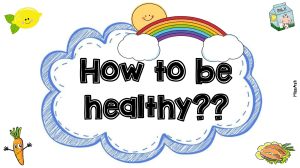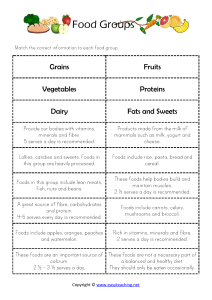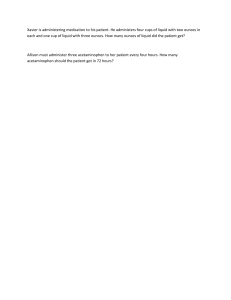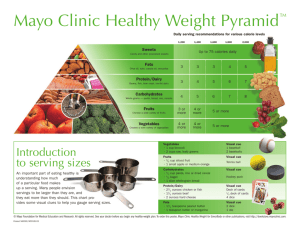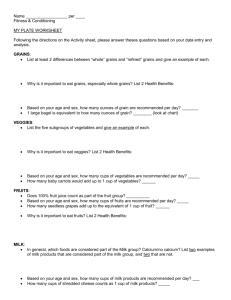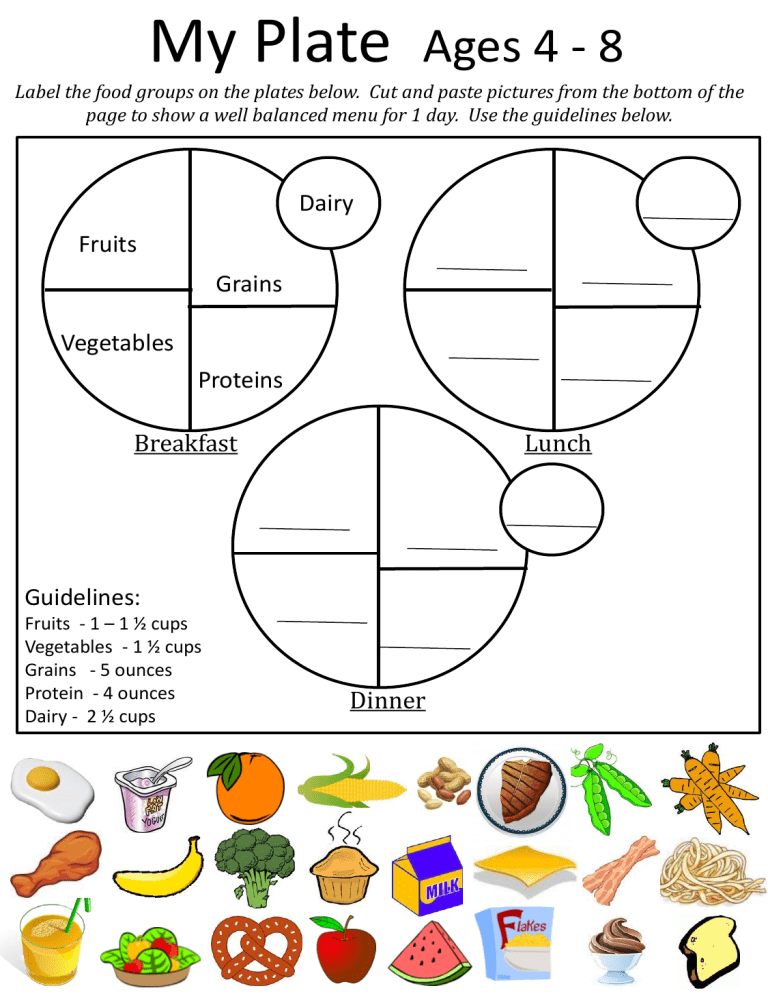
My Plate Ages 4 - 8 Label the food groups on the plates below. Cut and paste pictures from the bottom of the page to show a well balanced menu for 1 day. Use the guidelines below. Dairy Fruits Grains Vegetables Proteins Breakfast Lunch Guidelines: Fruits - 1 – 1 ½ cups Vegetables - 1 ½ cups Grains - 5 ounces Protein - 4 ounces Dairy - 2 ½ cups Dinner My Plate Example Ages 4 - 8 Label the food groups on the plates below. Cut and paste pictures from the bottom of the page to show a well balanced menu for 1 day. Use the guidelines below. Dairy Fruits Grains Vegetables Proteins Breakfast Lunch Guidelines: Fruits - 1 – 1 ½ cups Vegetables - 1 ½ cups Grains - 5 ounces Protein - 4 ounces Dairy - 2 ½ cups Dinner Fruits My Plate Ages 4 – 8 Small fruits like apples , oranges, peaches and plums will count as a ½ cup serving. If you are drinking juice, you will need to remember that 4 ounces is the same as ½ cup. Larger fruits like watermelon, cantaloupe or pineapple will need to be eaten in moderation. Try comparing your servings size of them to that of a small apple. You will need 1 to 1 ½ cups of fruits per day. Vegetables The serving size of vegetable will vary depending on the size of the vegetable. 1 corn on the cob will count as 1 serving or ½ cup. A large sweet potato may count as 1 whole cup. If you stick to eating ½ cup portions you will need to eat 3 servings of vegetables a day which is the same as 1 ½ cups. Grains Bread, pasta, oatmeal, rice, breakfast cereals, and tortillas are examples of grains. We need 5 ounces of grains per day. You will need to look up the ounces on the packages of the grains that you eat. They will vary depending on the size of the food. Most slices of bread are equal to 2 ounces. Protein All foods made from meat, poultry, seafood and beans are part of the Protein group. Eggs, nuts and seeds are also considered part of the protein food group. You need to eat no more than 4 ounces of protein per day. One egg is about 1 ounce. One slice of bacon is also about 1 ounce. Other meats like steak or chicken should be small enough to fit in the palm of your hand. That amount would be considered about 2 ounces. Dairy Foods made from milk that retain their calcium content are part of the dairy group. This includes cheeses, milk, and yogurt. We need to eat 2 ½ cups of dairy per day. You will need to read the label to see how many ounces each food item has per serving. Remember 8 ounces = 1 cup. My Plate Ages 9 - 13 Label the food groups on the plates below. Cut and paste pictures from the bottom of the page to show a well balanced menu for 1 day. Use the guidelines below. Dairy Fruits Grains Vegetables Proteins Breakfast Lunch Guidelines: Fruits - 1 ½ cups Vegetables - 2 cups girls, 2 ½ cups boys Grains - 5 oz. girls, 6 oz. boys Protein – 5 ounces Dairy – 3 cups Dinner My Plate Example Ages 9 - 13 Label the food groups on the plates below. Cut and paste pictures from the bottom of the page to show a well balanced menu for 1 day. Use the guidelines below. Dairy Fruits Grains Vegetables Proteins Breakfast Lunch Guidelines: Fruits - 1 ½ cups Vegetables - 2 cups girls, 2 ½ cups boys Grains - 5 oz. girls, 6 oz. boys Protein – 5 ounces Dairy – 3 cups Dinner My Plate Ages 9 – 13 Fruits Small fruits like apples , oranges, peaches and plums will count as a ½ cup serving. If you are drinking juice, you will need to remember that 4 ounces is the same as ½ cup. Larger fruits like watermelon, cantaloupe or pineapple will need to be eaten in moderation. Try comparing your servings size of them to that of a small apple. You will need 1 ½ cups of fruits per day. Vegetables The serving size of vegetable will vary depending on the size of the vegetable. 1 corn on the cob will count as 1 serving or ½ cup. A large sweet potato may count as 1 whole cup. If you stick to eating ½ cup portions you will need to eat 4 to 5 servings of vegetables a day which is the same as 2 – 2 ½ cups. Grains Bread, pasta, oatmeal, rice, breakfast cereals, and tortillas are examples of grains. We need 5 -6 ounces of grains per day. You will need to look up the ounces on the packages of the grains that you eat. They will vary depending on the size of the food. Most slices of bread are equal to 2 ounces. Protein All foods made from meat, poultry, seafood and beans are part of the Protein group. Eggs, nuts and seeds are also considered part of the protein food group. You need to eat no more than 5 ounces of protein per day. One egg is about 1 ounce. One slice of bacon is also about 1 ounce. Other meats like steak or chicken should be small enough to fit in the palm of your hand. That amount would be considered about 2 ounces. Dairy Foods made from milk that retain their calcium content are part of the dairy group. This includes cheeses, milk, and yogurt. We need to eat 3 cups of dairy per day. You will need to read the label to see how many ounces each food item has per serving. Remember 8 ounces = 1 cup. My Plate Ages 14 – 18 Label the food groups on the plates below. Cut and paste pictures from the bottom of the page to show a well balanced menu for 1 day. Use the guidelines below. Dairy Fruits Grains Vegetables Proteins Breakfast Lunch Guidelines: Fruits - 1 ½ cups girls, 2 cups boys Vegetables - 2 ½ cups girls, 3 cups boys Grains - 6 oz. girls, 8 oz. boys Protein – 5 oz. girls, 6 oz. boys Dairy – 3 cups Dinner My Plate Example 14 – 18 Label the food groups on the plates below. Cut and paste pictures from the bottom of the page to show a well balanced menu for 1 day. Use the guidelines below. Dairy Fruits Grains Vegetables Proteins Breakfast Lunch Guidelines: Fruits - 1 ½ cups girls, 2 cups boys Vegetables - 2 ½ cups girls, 3 cups boys Grains - 6 oz. girls, 8 oz. boys Protein – 5 oz. girls, 6 oz. boys Dairy – 3 cups Dinner My Plate Ages 14 – 18 Fruits Small fruits like apples , oranges, peaches and plums will count as a ½ cup serving. If you are drinking juice, you will need to remember that 4 ounces is the same as ½ cup. Larger fruits like watermelon, cantaloupe or pineapple will need to be eaten in moderation. Try comparing your servings size of them to that of a small apple. You will need 1½ - 2 cups of fruits per day. Vegetables The serving size of vegetable will vary depending on the size of the vegetable. 1 corn on the cob will count as 1 serving or ½ cup. A large sweet potato may count as 1 whole cup. If you stick to eating ½ cup portions you will need to eat 4 to 5 servings of vegetables a day which is the same as 2 ½ - 3 cups. Grains Bread, pasta, oatmeal, rice, breakfast cereals, and tortillas are examples of grains. We need 6 - 8 ounces of grains per day. You will need to look up the ounces on the packages of the grains that you eat. They will vary depending on the size of the food. Most slices of bread are equal to 2 ounces. Protein All foods made from meat, poultry, seafood and beans are part of the Protein group. Eggs, nuts and seeds are also considered part of the protein food group. You need to eat no more than 5 – 6 ounces of protein per day. One egg is about 1 ounce. One slice of bacon is also about 1 ounce. Other meats like steak or chicken should be small enough to fit in the palm of your hand. That amount would be considered about 2 ounces. Dairy Foods made from milk that retain their calcium content are part of the dairy group. This includes cheeses, milk, and yogurt. We need to eat 3 cups of dairy per day. You will need to read the label to see how many ounces each food item has per serving. Remember 8 ounces = 1 cup.

